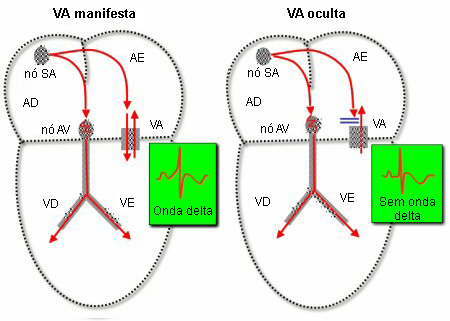Resumo
Definição
História e exame físico
Principais fatores diagnósticos
- presença de fatores de risco
- taquicardia reentrante atrioventricular (TRAV)
Outros fatores diagnósticos
- palpitações
- tontura
- dispneia
- dor torácica
- fibrilação atrial
- flutter atrial
- anomalias cardíacas congênitas
- morte súbita cardíaca
- síncope e pré-síncope
- taquicardia na gestação
Fatores de risco
- Anomalia de Ebstein
- cardiomiopatia hipertrófica
- prolapso da valva mitral
- defeito do septo atrial
- defeito do septo ventricular
- transposição dos grandes vasos
- coarctação aórtica
- dextrocardia
- divertículos do seio coronário
- aneurismas atriais à direita e esquerda
- rabdomiomas cardíacos
- Síndrome de Marfan
- ataxia de Friedreich
- história familiar
Investigações diagnósticas
Primeiras investigações a serem solicitadas
- eletrocardiograma (ECG) de 12 derivações
Investigações a serem consideradas
- ecocardiograma
- teste ergométrico
- estudo eletrofisiológico
Algoritmo de tratamento
instável: PA <90/60 mmHg, sinais de hipoperfusão sistêmica ou fibrilação atrial instável
estável: taquicardia (reciprocante atrioventricular ortodrômica) de complexo estreito
estável: taquicardia (reciprocante atrioventricular ortodrômica) de complexo largo
estável: taquicardia pré-excitada devido à fibrilação atrial ou flutter atrial
estável: taquicardia pré-excitada devido à taquicardia atrial
após o tratamento do quadro agudo: assintomáticos
após o tratamento do quadro agudo: sintomáticos
Colaboradores
Autores
Hugh Calkins, MD
Professor of Medicine
Director of Electrophysiology
Johns Hopkins University School of Medicine
Baltimore
MD
Declarações
HC declares that he is a consultant for Medtronic, Biosense Webster, Abbott, and Boston Scientific.
Agradecimentos
We would like to acknowledge our cardiology expert panel member, Dr Fred Kusumoto, for his contribution to this topic.
Professor Hugh Calkins would like to gratefully acknowledge Dr David Frankel, Dr Mithilesh K. Das, and Dr Douglas P. Zipes, previous contributors to this topic.
Declarações
DF, MKD, and DPZ declare that they have no competing interests.
Revisores
Nicolas Palaskas, MD, FACC
Assistant Professor
University of Texas MD Anderson Cancer Center
Houston
TX
Declarações
NP declares that he has no competing interests.
Joseph E. Marine, MD
Associate Professor of Medicine
Director of Electrophysiology
Johns Hopkins University School of Medicine
Baltimore
MD
Declarações
JEM declares that he has no competing interests.
Suneet Mittal, MD
Director
Electrophysiology Laboratory
The St. Luke's-Roosevelt Hospital Center
New York
NY
Declarações
SM declares that he has no competing interests.
Andrew Turley, MB ChB
Cardiology Specialist Registrar
The James Cook University Hospital
Middlesbrough
UK
Declarações
AT declares that he has no competing interests.
Steve Hsu, MD
Associate Professor
Department of Medicine
Division of Cardiology
University of Florida College of Medicine
Jacksonville
FL
Declarações
SH declares that he has no competing interests.
Créditos aos pareceristas
Os tópicos do BMJ Best Practice são constantemente atualizados, seguindo os desenvolvimentos das evidências e das diretrizes. Os pareceristas aqui listados revisaram o conteúdo pelo menos uma vez durante a história do tópico.
Declarações
As afiliações e declarações dos pareceristas referem--se ao momento da revisão.
Referências
Principais artigos
Brugada J, Katritsis DG, Arbelo E, et al. 2019 ESC Guidelines for the management of patients with supraventricular tachycardiaThe Task Force for the management of patients with supraventricular tachycardia of the European Society of Cardiology (ESC). Eur Heart J. 2020 Feb 1;41(5):655-720.Texto completo Resumo
Zeppenfeld K, Tfelt-Hansen J, de Riva M, et al. 2022 ESC Guidelines for the management of patients with ventricular arrhythmias and the prevention of sudden cardiac death. Eur Heart J. 2022 Oct 21;43(40):3997-4126.Texto completo Resumo
Page RL, Joglar JA, Caldwell MA, et al. 2015 ACC/AHA/HRS guideline for the management of adult patients with supraventricular tachycardia: a report of the American College of Cardiology/American Heart Association Task Force on Clinical Practice Guidelines and the Heart Rhythm Society. J Am Coll Cardiol. 2016;67:e27-e115.Texto completo Resumo
Artigos de referência
Uma lista completa das fontes referenciadas neste tópico está disponível para os usuários com acesso total ao BMJ Best Practice.

Diagnósticos diferenciais
- Via atriofascicular
- Síndrome de Lown-Ganong-Levine
- Via nodofascicular
Mais Diagnósticos diferenciaisDiretrizes
- 2023 AHA/ACC/HRS guideline for the management of patients with atrial fibrillation
- 2022 ESC guidelines for the management of patients with ventricular arrhythmias and the prevention of sudden cardiac death
Mais DiretrizesFolhetos informativos para os pacientes
Fibrilação atrial: quais são as opções de tratamento?
Fibrilação atrial: o que é?
Mais Folhetos informativos para os pacientesConectar-se ou assinar para acessar todo o BMJ Best Practice
O uso deste conteúdo está sujeito ao nosso aviso legal